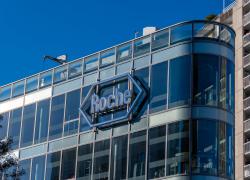
Pfizer hopes not to get stung
New clinical trial entrants include the group’s attempt at targeting Sting, a field that has seen many setbacks.
New clinical trial entrants include the group’s attempt at targeting Sting, a field that has seen many setbacks.

Trying to hit the Sting pathway hasn't gone well in the past, but Pfizer clearly hopes to do better with PF-07820435, a Sting agonist that has recently entered the clinic. Perhaps the company hopes oral delivery will make a difference; a look at OncologyPipeline shows no other clinical-stage Sting agonists that are delivered orally.
Meanwhile, two Chinese companies are pressing ahead with 4-1BB bispecifics despite the poor track record of adding co-stimulatory domains to cancer therapies. And another ROR1 project has entered the clinic, from the private Swiss company Numab Therapeutics.
Sting by mouth
Pfizer’s phase 1 trial will evaluate PF-07820435 as monotherapy, or in combination with the group’s subcutaneous PD-1 inhibitor sasanlimab, in various solid tumours. Despite various setbacks in Sting agonistm, most notably from Aduro, there has been a resurgence of interest in this target.
While Aduro’s ADU-S100 was injected intratumourally, other groups have been developing intravenous projects that, it is said, might allow treatment of hard-to-reach cancers.
However, GSK recently discontinued an IV Sting candidate, GSK3745417. That group also has an option on Mersana’s XMT-2056, an antibody-drug conjugate targeting HER2 that has a Sting agonist payload, and which came off clinical hold late last year.
Takeda has a similar ADC, TAK-500, which delivers a Sting payload and hits CCR2; early data were presented at last year’s ESMO.
Co-stimulation concerns
Another cancer avenue that has so far proven a dead end is the addition of co-stimulatory domains, and this field took another blow last month when Inhibrx discontinued its anti-PD-L1 x 4-1BB bispecific INBRX-105.
The new contenders, Beijng Immunoah’s IMB071703 and SunHo BioPharmaceutical’s IBD0333, are an anti-CD40 x 4-1BB fusion protein and an anti-CD24 x 4-1BB bispecific MAb respectively. So far, the projects are only being studied in China.
CD40 has had somesetbacks, including Roche discontinuing selicrelumab and Johnson & Johnson walking away from Alligator’s mitazalimab (ADC-1013) in 2019. Development of the latter continues, with Alligator reporting data from the phase 2 Optimise-1 trial in first-line pancreatic cancer earlier this year, swiftly followed by a restructuring.
Meanwhile, there are only a handful of clinical-stage assets hitting CD24, according to OncologyPipeline.
Time to ROR?
A more popular target is ROR1; indeed, only last month ApexOnco flagged the clinical trial entrance of Pure Biologics’ PBA-0405, a CD16-based NK-cell engager. Other ROR1-targeting assets include Oncternal’s Car-T therapy ONCT-808 and Merck & Co’s ADC zilovertamab vedotin, acquired through the $2.8bn purchase of VelosBio; however, several projects have fallen by the wayside.
Numab’s NM32-2668, meanwhile, is a trispecific comprising an anti-ROR1 domain, a CD3-binding T-cell engaging domain, and a human serum albumin domain to prolong the molecule’s half-life, the company says. The group’s approach looks similar to that of Harpoon Therapeutics, whose acquisition Merck & Co completed today.
Other projects to hit the clinic in the past couple of weeks include Sana’s allogeneic CD22-targeting Car-T SC262, which joins the group’s CD19-targeting SC291. Sana’s assets are designed to be hypoimmune thanks to CD47 overexpression, which might help tackle the lack of durability seen with allo Car-T – although this still needs to be proven.
And 23andMe, better known for its consumer DNA testing, has taken a second project into humans. 23ME-01473, described as an NK cell activator, is the only asset in development targeting ULBP-6, according to OncologyPipeline. The group has one other clinical-stage asset, 23ME-00610, a MAb against another novel target, CD200R1.
Recently disclosed first-in-human studies*
| Project | Mechanism | Company | Trial | Scheduled start |
|---|---|---|---|---|
| PF-07820435 | STING agonist | Pfizer | Post-PD-(L)1 solid tumours | 8 Feb 2024 |
| IMB071703 | Anti-CD40 x 4-1BB fusion protein | Beijng Immunoah | Solid tumours | 24 Feb 2024 |
| CCTx-001 | IL-1RAP CAR-T | Advesya | Resolve AML001 in r/r AML | Feb 2024 |
| 23ME-01473 | Anti-ULBP-6 Fc-enhanced MAb | 23andMe | Unspecified | 1 Mar 2024 |
| IBD0333 | Anti-CD24 x 4-1BB bispecific | SunHo BioPharmaceutical | Solid tumours | 2 Mar 2024 |
| NM32-2668 | Anti-ROR1 T-cell engager trispecific | Numab Therapeutics | ROR1+ve solid tumours | 29 Mar 2024 |
| DA-4505 | AhR antagonist | Dong-A ST | +/-Keytruda | Mar 2024 |
| BRY805 | Anti-NKG2A MAb | BioRay Pharmaceutical | Solid tumours | Mar 2024 |
| SC262 | HIP-modified CD22 allogeneic CAR-T | Sana | Vivid, r/r lymphomas after ≤1 prior CD19 Car-T therapy | Apr 204 |
| DCC-3084 | Pan-RAF inhibitor | Deciphera | MAPK pathway-driven cancers | May 2024 |
| 3HP-2827 | FGFR2 inhibitor | 3H Pharmaceuticals | FGFR2-altered solid tumours | Jun 2024 |
Note: *projects newly listed on the clinicaltrials.gov database between 24 Feb and 7 Mar 2024.
2090













